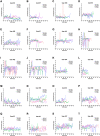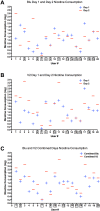Puffing topography and nicotine intake of electronic cigarette users
- PMID: 25664463
- PMCID: PMC4321841
- DOI: 10.1371/journal.pone.0117222
Puffing topography and nicotine intake of electronic cigarette users
Abstract
Background: Prior electronic cigarette (EC) topography data are based on two video analyses with limited parameters. Alternate methods for measuring topography are needed to understand EC use and nicotine intake.
Objectives: This study evaluated EC topography with a CReSS Pocket device and quantified nicotine intake.
Methods: Validation tests on pressure drop, flow rate, and volume confirmed reliable performance of the CReSS Pocket device. Twenty participants used Blu Cigs and V2 Cigs for 10 minute intervals with a 10-15 minute break between brands. Brand order was reversed and repeated within 7 days Data were analyzed to determine puff duration, puff count, volume, flow rate, peak flow, and inter-puff interval. Nicotine intake was estimated from cartomizer fluid consumption and topography data.
Results: Nine patterns of EC use were identified. The average puff count and inter-puff interval were 32 puffs and 17.9 seconds. All participants, except one, took more than 20 puffs/10 minutes. The averages for puff duration (2.65 seconds/puff), volume/puff (51 ml/puff), total puff volume (1,579 ml), EC fluid consumption (79.6 mg), flow rate (20 ml/s), and peak flow rate (27 ml/s) were determined for 10-minute sessions. All parameters except total puff count were significantly different for Blu versus V2 EC. Total volume for Blu versus V2 was four-times higher than for conventional cigarettes. Average nicotine intake for Blu and V2 across both sessions was 1.2 ± 0.5 mg and 1.4 ± 0.7 mg, respectively, which is similar to conventional smokers.
Conclusions: EC puffing topography was variable among participants in the study, but often similar within an individual between brands or days. Puff duration, inter-puff interval, and puff volume varied from conventional cigarette standards. Data on total puff volume and nicotine intake are consistent with compensatory usage of EC. These data can contribute to the development of a standard protocol for laboratory testing of EC products.
Conflict of interest statement
Figures





References
Publication types
MeSH terms
Substances
Grants and funding
LinkOut - more resources
Full Text Sources
Other Literature Sources
Medical
Miscellaneous

